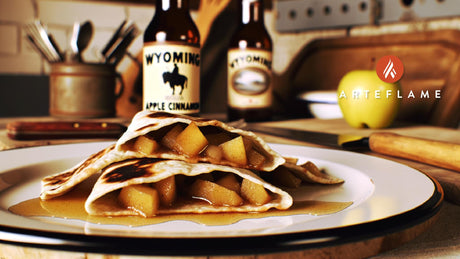
Wyoming Apple Cinnamon Grilled Dessert Wraps
These Wyoming Apple Cinnamon Grilled Dessert Wraps are sweet, crisp, and cooked perfectly on your Arteflame grill—bringing campfire comfort to dessert.
Pro tip: Cuts that run along the back tend to be the most tender and expensive.
The butcher counter can feel overwhelming, filled with countless options but little explanation. While there’s no single “best” cut of steak—it really comes down to personal taste and preparation—some cuts are universally prized for tenderness, flavor, and versatility. Below, we’ll break down the differences between the most popular cuts, plus the single cooking technique that makes any steak taste amazing: searing at 1,000°F.
The best cuts are all found along the cow’s back, far from the hardworking muscles of the legs and shoulders. Muscles that move more (like brisket or shank) become tougher and require slow cooking, while back cuts stay tender and juicy—perfect for grilling. That’s why ribeye, strip, tenderloin, and T-bone are the classics.
Before we dive in, let’s talk marbling. Marbling refers to the small streaks of white fat woven through a cut. This isn’t the chewy fat you trim off—it’s the flavor-packed fat that melts during cooking, making your steak juicy and richly flavored. Cuts with more marbling almost always deliver better flavor and texture.
Large, round, and beautifully marbled, ribeye is bold in flavor and luxuriously tender. Sold boneless or bone-in, it’s a steakhouse favorite for a reason.
Also called the New York Strip, this cut is rectangular, often boneless, and deeply flavorful. Though slightly less tender than ribeye, it’s still a high-end choice with excellent marbling.
The most tender cut of all, the tenderloin is long and lean with little marbling. Filet mignon comes from the tenderloin’s smaller end, prized for melt-in-your-mouth texture. Since it lacks marbling, it’s often paired with a butter-based sauce to boost flavor.
A steak lover’s dream: half strip, half tenderloin, separated by the bone. It’s both flavor and tenderness in one cut. Porterhouse steaks are simply larger versions of the T-bone with more tenderloin.
| Cut | Tenderness | Marbling (Flavor) | Best Doneness | How 1,000°F Sear Makes It Amazing |
|---|---|---|---|---|
| Ribeye | Very tender | High – rich, buttery | Medium-rare (130–135°F) | Instantly caramelizes marbling into a bold, steakhouse crust while keeping the inside juicy. |
| Strip Steak (NY Strip) | Tender | Moderate – beefy flavor | Medium-rare (130–135°F) | Deepens its natural rich flavor, adding a smoky, crisp crust without drying out. |
| Tenderloin / Filet Mignon | Extremely tender | Very low – mild flavor | Rare to medium-rare (125–130°F) | Builds the rich crust it naturally lacks, adding flavor to its melt-in-your-mouth texture. |
| T-Bone / Porterhouse | Combination – filet + strip | Mixed – tender + flavorful | Medium-rare (130–135°F) | Searing both sides quickly enhances the strip’s bold flavor and gives the filet a beautiful crust. |
| Sirloin | Leaner, moderately tender | Low – less marbling | Medium (140–145°F) | Turns a lean cut into a flavorful steak with a golden-brown crust and smoky richness. |
This chart makes it clear: no matter the cut, a 1,000°F sear transforms it into steakhouse quality.
No matter which cut you choose—ribeye, strip, tenderloin, or T-bone—your cooking method determines how it will taste. The real secret to steakhouse quality is starting with a 1,000°F sear.
At this temperature, the steak’s exterior caramelizes instantly, locking in juices and unleashing rich, savory flavors. This is the Maillard reaction at its best—the golden-brown crust that gives steak its signature aroma and depth. Cuts with heavy marbling become outrageously flavorful, while leaner cuts like sirloin or tenderloin develop the richness they often lack on their own.
With an Arteflame grill, achieving this level of heat is easy. The center grate reaches over 1,000°F for the sear, while the surrounding steel cooktop offers cooler zones to finish cooking your steak gently to the perfect doneness. It’s the combination of fire-kissed crust and controlled finishing that makes every cut—from ribeye to sirloin—taste unforgettable.
Tenderloin is generally the most expensive cut due to its extreme tenderness and limited supply. Add specialty breeds like Japanese wagyu or kobe beef, raised under strict standards for perfect fat distribution, and the price tag climbs even higher.
Ribeye is packed with marbling and flavor but comes at a higher price. Sirloin is leaner and more affordable, with less natural flavor—but when seared at high heat, even sirloin becomes beautifully juicy and flavorful.
Medium-rare (130–135°F) is widely considered the sweet spot for flavor and tenderness. Ribeye and strip shine at this temperature, as marbling melts into the meat while keeping the center perfectly pink.
Ribeye and strip steaks are excellent for grilling thanks to their thickness and marbling, which balance charred edges with tender centers. But with the right searing technique, any steak can achieve steakhouse results outdoors.
USDA Grading: Prime has the most marbling, followed by Choice, then Select.
Dry Aging: Improves tenderness and flavor, but raises the price.
Thickness: Thicker steaks are easier to cook perfectly with a crisp sear and juicy center.
Seasoning: Always salt generously before cooking to enhance flavor.
Choosing the right cut is important, but the real game-changer is how you cook it. Whether you’re grilling ribeye, strip, tenderloin, or T-bone, starting with a 1,000°F sear makes every steak taste amazing. That instant caramelization brings out flavors you simply can’t achieve at lower temperatures.
With an Arteflame grill, you get both extremes: a blazing-hot center grate for the crust, and cooler zones to finish the steak to your perfect doneness. Combine the right cut with the right technique, and every steak becomes an unforgettable experience.
Arteflame XXL 40" Flat Top Grill - High Euro Base
Arteflame ONE30 — 30″ One Series Flat-Top Charcoal Grill & Fire Bowl (Single-Piece CORTEN Steel)